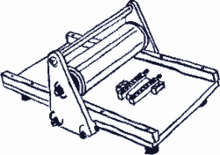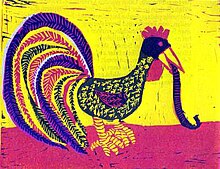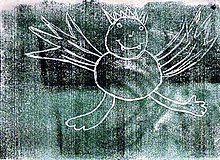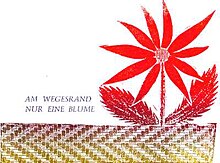School printing
The school printing is a work tool of the Freinet pedagogy in the elementary school and is also called "Freinet printing". It usually stands in a work corner (studio) and contains several font boxes with letters, characters and numbers of different sizes and shapes. Furthermore, a small press belongs to the scope of the school print shop. The entire print shop is passed on to the teaching staff every six months, for example, so that everyone is able to use it for their own class during free work .
Here, the students can set and print texts they have written themselves - using normal materials and equipment from book printing. For it must always lead letter ( Letter ) by hand in a brass holder (Setzrähmchen) screwed and row are placed on line on a press. The lines are then rolled in with printing ink and printed on a folding wing press or roller press.
Often the texts are illustrated and the pages are processed into books or calendars. Common image printing techniques in school include linocut , cardboard printing, wood veneer printing, material printing and polystyrene printing.
In addition to its use in primary schools (as part of the Freinet pedagogy), school printing was also popular as a printing company in secondary schools. School printing has been supplanted or replaced by the use of computers at the school. The image printing techniques will continue to have their place in the art class.
Goals of the "Freinet printing company"
The reform pedagogue Célestin Freinet was looking for a tool for free work with which the pupils could independently document, present and reproduce their own texts (from their lives, free expression). This was done in a work corner (studio) with printing materials that Freinet and other teachers developed for the children.
- His main goal of working with the print shop was to “give the floor to the children” and “get away from the textbooks”.
- The print shop encourages spontaneous and creative writing and promotes spelling.
- The texts from the lifeworld (free expression) partly replace the primer (reading aloud, lessons based on your own texts).
- The class newspapers are sent to correspondence classes (communication with other cities and countries).
- It motivates to work independently and supports social learning in the group (cooperation and mutual help).
- The illustrations deepen your own experience, experiment or excursion.
Material and equipment
In some cases, special materials and devices were developed for the hand of the students. Freinet and other teachers founded a cooperative that further developed these materials and sold them cheaply.
- Letters (letters)
The fonts with which texts are set in primary school are mostly available in font sizes (font sizes) 24 point (running text) and 36 point (for headings). The fonts often used are Garamond or Times (with serifs) or Arial or Univers (sans serif). They are even cast with a lead-free alloy for children.
Typefaces with font sizes over 20 point are usually stored in a box. The letters are arranged in alphabetical order. There are even special Freinet type cases in landscape format (see photo).
- Frame
Instead of the square hook , the letters are set in a small frame to form a word or a line. The setting frame consists of thin metal rails and a locking screw with the help of which the letters are held together after they have been filled with blank material. The frames are available for different font sizes (24p and 36p).
- Inking roller and coloring board
At school we use the linoleum roller as a rubber roller to evenly apply the printing ink to the printing form. Before the printing form (letters or image printing form) is rolled in, the roller rubs the color into a uniform film on a bathroom tile, glass or wooden panel.
- Folding wing press
C. Freinet was looking for a press that was easy for children to use. He found the folding wing press, in which texts (in frames) can be printed in A5 format.
- Roller press
A simple printing press (formerly for proofs) for texts (in frames) and blocked picture printing blocks.
Image printing techniques
The following procedures are possible in elementary school. Most of them are letterpress printing, in which the printing block is either turned by a linoleum press or has to be blocked to letter height for the roller press. In addition to linocut, Freinet was also familiar with cardboard printing, wood veneer printing, cord printing and the limograph. More difficult processes such as drypoint etching ( gravure printing ) or screen printing are used in secondary schools.
- Linocut:
Linocut is the best known picture printing technique. You can use it from the first grade, as PVC flooring residues can be easily cut. Some safety rules must be observed: The linoleum sheet to be cut should be placed on a cutting board. The cutting knife set, consisting of a carving knife, gouge with blade and goat foot (V-shaped blade), should be sharp so that it can be cut with little effort. The "holding hand" is protected with a work glove. Linoleum is easier to cut if it is heated a little. Leftovers from PVC floor coverings can be cut even more easily and finely.
There are many ways to work creatively with these materials. However, as with all letterpress printing techniques, one thing is the same here: the raised parts print, the cut-away parts do not.
The "lost" plate: This particularly creative printing technique is best done as a linocut or cardboard scratch and peel print.
First, a draft is made on thin paper. This is placed the wrong way round on the pressure plate and pushed through. The lines are trimmed.
The printing plate is first rolled in with the lightest color and printed with a press. A white line print is created. The areas that are to be retained in the first printing color are cut out of the printing plate. The printing plate is rolled in a darker color and printed in the press to match the first color.
This process can be repeated with several colors. The darkest color is always printed last.
- Cardboard printing
With cardboard printing, there is the option of cutting out shapes from the material, as with veneer printing, and sticking them onto a cardboard box.
A more sophisticated type of cardboard printing is cardboard scoring and peeling. Gray cardboard is used for this creative printing technique. The drawing is spontaneously imprinted into the box with a bone folder or with a ballpoint pen. It can also be transferred from a draft. The contours of the drawing are scratched with the cutter. Areas that should not be fully printed can now be lifted off with the knife - to different depths. Smaller areas that should remain white can be cut out completely. The processed plate is brought to the correct height by placing it underneath, colored and printed in the press. The printing process can be repeated with other colors after changes to the plate.
- Wood veneer printing
Veneer printing is suitable for children in the first and second grade.
The back of the veneer is glued with double-sided adhesive tape. Now the motifs can be cut out with scissors and nail scissors without the thin veneer splitting. Then the protective film of the adhesive tape is removed and the motif is glued to the cardboard.
When printing, it is important to use solvent-based inks so that the fine grain of the wood comes into its own.
- Polystyrene print
With polystyrene printing, the drawing is scratched into the soft material (fine-pored styrofoam).
When printing, a white line graphic is created in which the structure of the polystyrene also has an effect.
- Material pressure
All flat-lying materials with a strong structure are suitable for this, e.g. B. fabrics, jute, furs, rough cardboard boxes, textured wallpaper, leaves, grass, cords, wool. The materials are glued to a strong cardboard box.
This technique encourages experimentation and spontaneous work, as the combination of different materials creates new design options. The collage-like printing plates are colored and printed on a lino or roller press.
- Limograph
Freinet also used the Limograf - a kind of screen printing with a wax matrix, as it was used in the stencil printer earlier. The students were able to draw lines on it. The die is glued under an A4 screen frame. The slowly drying Limograph paint is pressed through with a wide rubber squeegee.
- Drypoint etching
As an art teacher in Ravensburg, Josef Koranda experimented a lot with the children. He even used drypoint etching in elementary school. The drawing lies under a transparent Rhenalon plate and the children scratch their motif with a steel needle. As with normal gravure printing , the ink is rubbed into the grooves with a soft pad and then the excess ink is wiped away from the smooth surface. The printing plate can now be rotated through a linoleum press with damp handmade paper that you have made yourself.
See also
- Freinet pedagogy , Célestin Freinet
- Hand type / lead type , type case / angle hook
- Graphics , linocut
literature
- Célestin Freinet : Printing in School . Boulogne 1927.
- C. Freinet: L'Imprimerie à l'Ecole . Verlag der F.reinet movement, Vence 1935 (translated by G. Hertler: Die Druckerei in der Schule . SDZ contributions from PH Ludwigsburg, 1995).
- Hans Jörg: Students print their primers themselves . Wolfsburg 1991.
- Gerhard Honig: Printing in school . Wolfsburg 1992.
- Herbert Hagstedt: The school print shop - from the beginning until today . AKS-Information 12, Wolfsburg 2000.
- E. Dettinger, R. Mangold (Hrsg.): AKS information booklets on school printing and image printing techniques . Wolfsburg 1991-2006.
- Josef Koranda: various image printing techniques in AKS information booklets and in Die Gestalt . 1990–1 / 2009.
- Dieter Adrion (Hrsg.): Machart - Printed pictures and their history of origin . SDZ contributions 3, PH-Ludwigsburg 1991.
Web links
- Step-by-step instructions from Rolf Wagner
- Working group for school printing literature, lexicon and picture print gallery of the AKS
- School printing center at the PH Ludwigsburg
- Freinet cooperative in Bremen
- School printing at freinet.paed.com








